BadwaterJournal.com
WHAT UNSUSTAINABLE URBAN GROWTH LOOKS LIKE

BadwaterJournal.com
WHAT UNSUSTAINABLE URBAN GROWTH LOOKS LIKE
Published online at Louisville, Kentucky USA -
An independent, secular, contemporary journal of political and environmental issues dedicated to peaceful reduction of human impacts on Earth

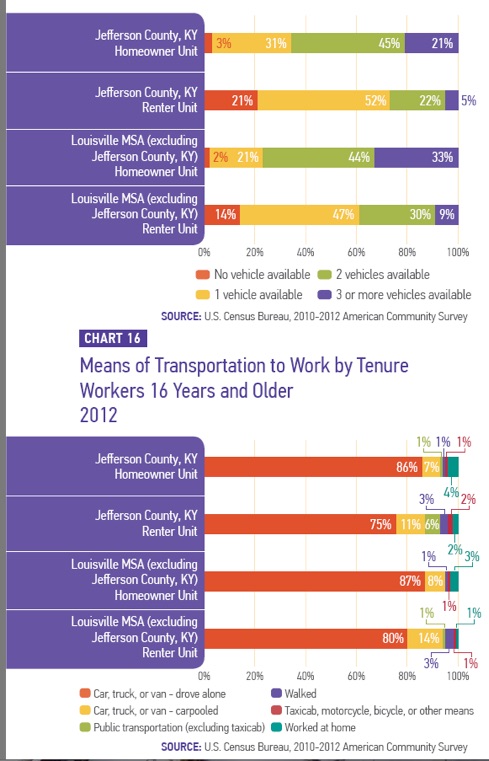
On February 8, 2010, the Securities & Exchange Commission issued new rules requiring companies to discuss possible climate change impacts to their bottom lines in reports sent to investors. See Federal Register Vol. 75, No. 25, 6290 - 6297:
“The Environmental Protection Agency is taking action to address climate change concerns, and Congress is considering climate change legislation. Some business leaders are increasingly
recognizing the current and potential effects on their companies’ performance and operations, both positive and negative, that are associated with climate change and with efforts to reduce greenhouse gas emissions. Many companies are providing information to their peers and to the public about their carbon footprints and their efforts to reduce them.”
Automakers meanwhile are selling millions of gasoline and diesel fuel burning vehicles in 2014 that will have street lives of 10-15 years or more meaning the fossil fuel fleet will still be composed of millions of carbon dioxide emitting vehicles well into 2030. The migration path to all electric vehicles is not expected to result in significant replacement of the fleet with electric vehicles.
See FORD’s climate change migration plan here:
http://corporate.ford.com/microsites/sustainability-report-2012-13/environment-climate
Purchasers of fossil fuel combusting vehicles this year may find regulatory burdens in the next decade including taxes on vehicle miles traveled and carbon taxes. The uncontrolled emissions of ultrafine particulates may lead to reduced driving days. The chance that climate change impacts and public demand for low carbon everything will accelerate over the same 15 year period is increasing. According to the most recent Intergovernmental Panel on Climate Change Report, by 2030 if the country stays on a high emissions path caused by failure to abate fossil fuel combustion the risk of catastrophic impacts will be high or very high. Headline grabbing impacts that trigger strong market reaction would include announcement of runaway methane release from melting permafrost, loss of ecological health due to ocean acidification, or one or more superstorms doing billions in damage.
FORD reports sales of 5.6 million vehicles per year or an average market share of about 15%. If the company is caught off guard by a sudden climate change development the market share in fossil fuel vehicles could be affected. Kentucky and Jefferson county jobs and local economic relationships could be significantly affected and the $ 240 million or so in state tax incentives granted to FORD in view of plant expansion to make SUVs could prove a poor investment.
As the Metro Housing 2013 Report shows in the graph at right, the workforce in Louisville commutes almost entirely by single occupant vehicles. 80-87 % of the workforce drives gas burners on concrete highways to work daily. TARC as a low emissions public transit alternative has been reduced to 3% or less of the public commute. Super low emission bicycles account for a lesser percentage.
As a responsible corporate citizen, and recipient of millions in state tax incentives FORD should respond to recent announcements from the IPCC and detail its adaptation to produce products that have lower carbon emissions. Constructing the infrastructure that automobiles depend upon, concrete bridges and highways are among the largest carbon emissions sources. Concrete infrastructure and fossil fuel burning single occupant vehicles are obsolete --when will FORD and Kentucky adapt ?
Automakers running out of
time to adapt to climate change to avoid market shock
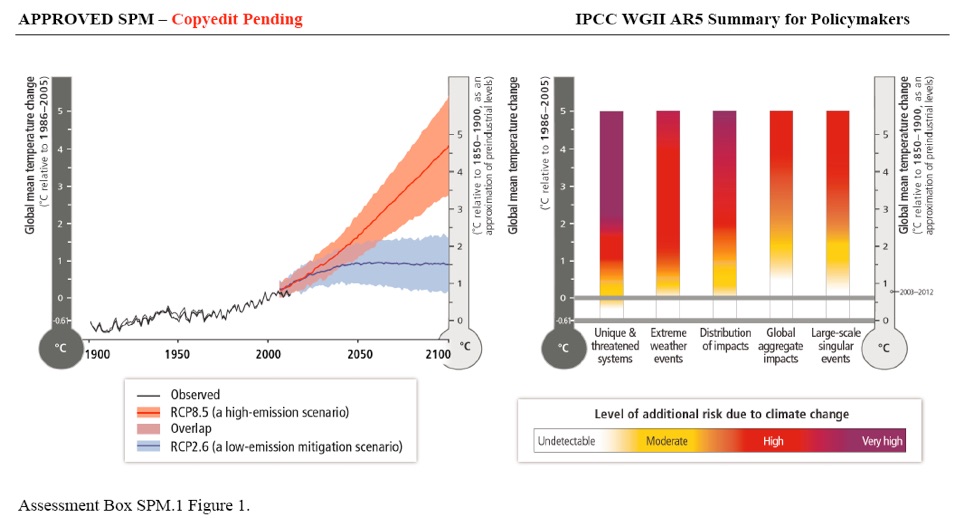
6,863 Jefferson County homeowners have no car available
22,978 Jefferson County renters have no car available
2013 State of Metropolitan Housing
“The workforce of employees 16 and older in Jefferson County is
estimated to be 338,215; of these workers,
• 228,795 (68 percent) live in owner-occupied households
• 109,420 (32 percent) are from renter-occupied households
In the Louisville MSA counties outside Jefferson County, nearly all of the workforce drive alone to get to their jobs. Of workers who live in owned homes, 87 percent drive alone to work as compared to 80 percent of the workers who live in rental housing units.
Of the workforce in Jefferson County, approximately 9,795 use public
transportation (excluding taxicabs) as a means to get to their jobs;
69 percent of these are from renter-occupied households and 31
percent are from owner-occupied housing units; this stresses the
need for affordable rental housing to be located along transit routes.
There are more renters who walk to work (3,795 out of 5,859) and
about 500 more workers from rental housing that get to their jobs by
either a taxicab, motorcycle, bicycle, or other means than workers
from owned housing (2,714 and 2,210 respectively). However, for the
3 percent of the total workforce who work at home, 80 percent do so
from households which are owner-occupied (U.S. Census Bureau,
2010-2012 American Community Survey). See Chart 16.”
2013 Metro Housing Report
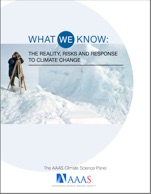
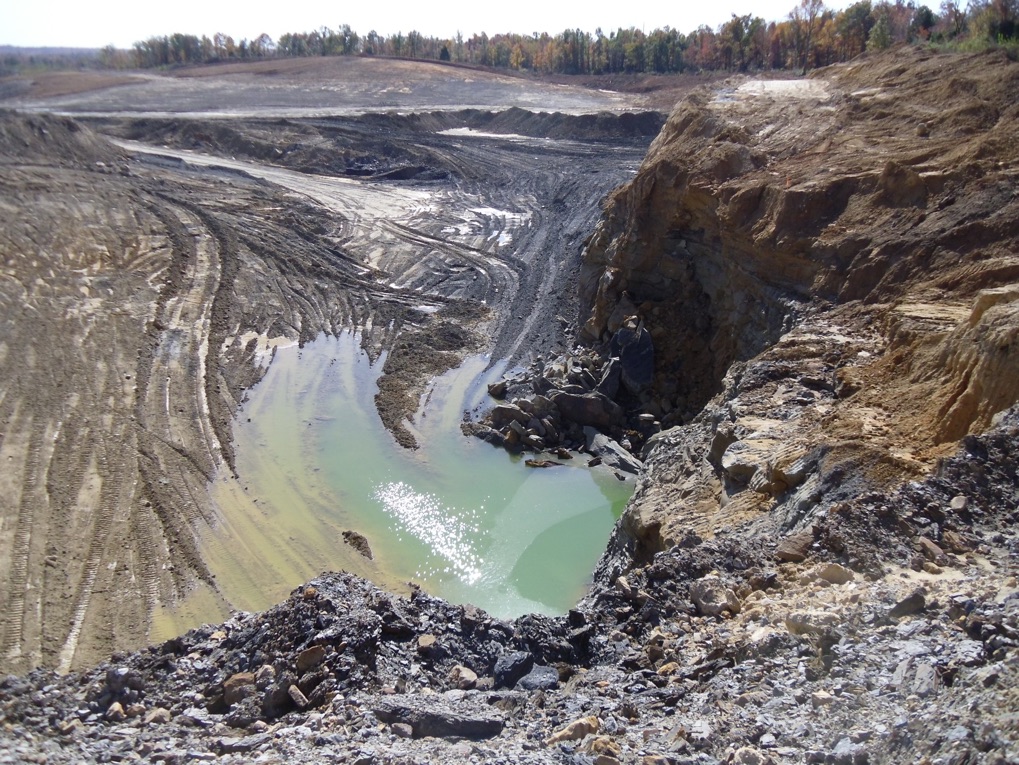
Earth Day 2014
Respect your mother


Dr. James Hansen to Congress,
“We have to phase out coal burning.”
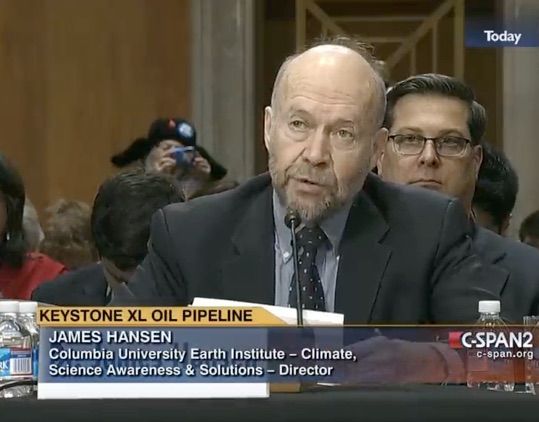
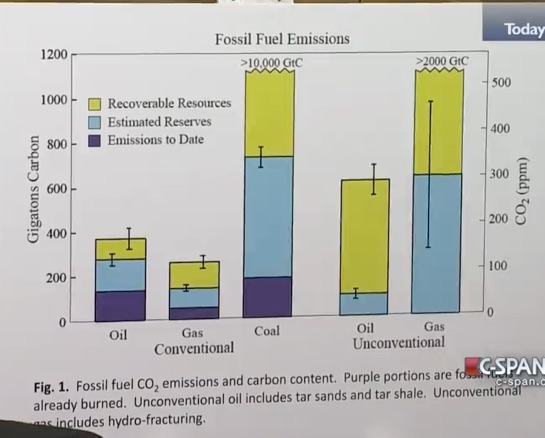
Saying the U.S. has already burned more than its equitable global share of fossil fuels, climate scientist James Hansen told Congress we are on the path to leaving our children a climate change scenario that will spin out of their control.
He appeared on March 13, 2014 to answer questions and share his knowledge based on his longterm research. He told members of the Senate Foreign Relations Committee, including Sen. Barbara Boxer, the tar sands product pumped through the Keystone XL Oil Pipeline are “among the dirtiest and most carbon intensive fuels” and “it makes no sense to set up a system to exploit them in a major way.”
In the slide at right the purple gigatons of carbon have already been emitted and Hansen warned that the additional fuel burned must be less than that already burned. Carbon dioxide concentration in the atmosphere is cumulative, leading to steady increasing ambient CO2 levels. Non-hydro power renewables provide just 3% of the energy in the U.S. and the world. Hansen called for a national policy to drive down use of carbon intensive fuels to “near zero.”
Carbon intensive fuels don’t pay the full cost of their impact to the environment and should have a $ 10 per ton carbon emissions fee. Dr. Hansen warned China was embarking on a massive scale coal gassification project that would essentially preclude future control of climate change. Many people watching the climate change policy debate have already concluded that the present political and business leaders lack the ability collectively to understand the threat and adapt to it.
Fugitive emissions: Western oil fields emit ozone of 100 million vehicles
Vast square miles of Utah, Colorado and Wyoming outback are becoming riddled with oil pump lots like the one at right. Laid out on a grid pattern in the deserts and prairies, the stations usually have a pump and one or more storage tanks and often a settling pond. Dirt roads connect the thousands of pump sites. Together the fugitive emissions from thousands of oil well sites contribute significant greenhouse gas emissions.
According to a new Environmental Science and Technology peer reviewed article, from the Institute of Arctic and Alpine Research (INSTAAR), at University of Colorado, Boulder:
“The total annual mass flux of C2−C7 Volatile Organic Carbon was estimated at 194 ± 56 X 106 kg yr−1, equivalent to the annual VOC emissions of a fleet of ∼100 million automobiles. Total annual fugitive emission of the aromatic compounds benzene and toluene, considered air toxics, were estimated at 1.6 ± 0.4 X 106 and 2.0 ± 0.5 X 106 kg yr−1, respectively. These observations reveal a strong causal link between oil and gas emissions, accumulation of air toxics, and significant production of ozone in the atmospheric surface layer.”
Highly Elevated Atmospheric Levels of Volatile Organic Compounds in the Uintah Basin, Utah, D. Helmig, C. R. Thompson, J. Evans, P. Boylan, J. Hueber, and J.-H. Park.
See the article HERE


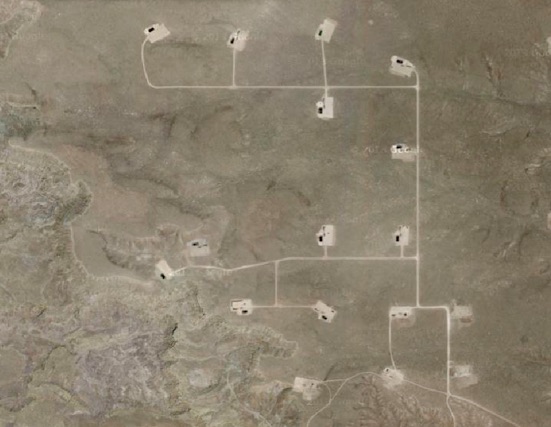
Hiking back into the desert of BLM land is no longer a guarantee of clean air unspoiled by urban traffic.
“The 2013 observations from the Uintah Basin oil and gas
development area are, to the best of our knowledge, among the highest ever reported mole fractions of alkane NMHCs in ambient air; mole fractions for the aromatic compounds reach or exceed those reported from the most heavily polluted inner cities. This is a remarkable finding, as the study region is a remote, rural Bureau of Land Management (BLM) area far distant from any major urban and industrial regions, which hitherto have been considered the primary emission regions for photochemical pollutants.”
The insatiable lust for petroleum driven by F-150s and Mustangs is leaving indelible marks on the landscape visible from high altitude satellites like the Google images shown at right. These are a small sampling of the pock marked land visible on Google Maps.
Another article, Anthropogenic emissions of methane in the United States, published by the National Academy of Sciences and using atmospheric methane emissions and computer modeling had less eye-popping results.
“This result suggests that regional methane emissions due to fossil fuel extraction and processing could be 4.9 ± 2.6 times larger than in EDGAR, the most comprehensive global methane inventory. These results cast doubt on the US EPA’s recent decision to downscale its estimate of national natural gas emissions by 25–30%. Overall, we conclude that methane emissions associated with both the animal husbandry and fossil fuel industries have larger greenhouse gas impacts than indicated by existing inventories.”
The prospects of closing fugitive emissions and reducing Green House Gas to meet climate change goals seems ever more unlikely.
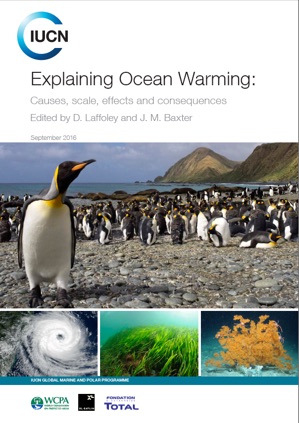
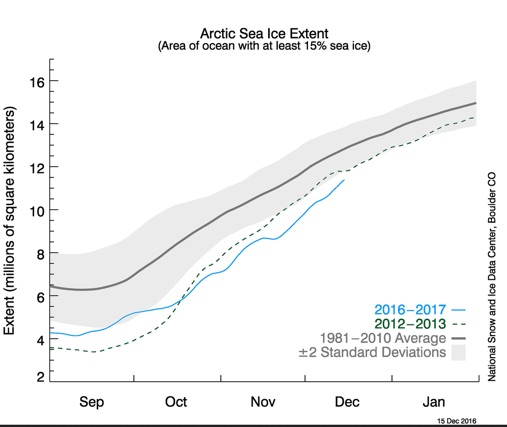
http://nsidc.org/arcticseaicenews/
“Average Arctic sea ice extent for November set a record low, reflecting unusually high air temperatures, winds from the south, and a warm ocean. Since October, Arctic ice extent has been more than two standard deviations lower than the long-term average. Antarctic sea ice extent quickly declined in November, also setting a record low for the month and tracking more than two standard deviations below average during the entire month. For the globe as a whole, sea ice cover was exceptionally low.”
15 December 2016
http://eprints.bournemouth.ac.uk/24741/1/IUCN%20Report%20Laffoley%20and%20Baxter%20(Eds)%202016.pdf#page=375
Paris COP21: An Unexpected Move Toward Global Target of 1.5 Degrees by Fred Pearce
10 Dec 2015
https://e360.yale.edu/digest/paris_cop21_an_unexpected_move_toward_global_target_of_15_degrees/4607/
Quoting Myles Allen, a climate analyst at Oxford University:
“Since we are already at one degree of warming, "the maths is simple," he says. "To limit warming to 2 degrees, CO2 emissions need to fall, on average, by 10 percent for every tenth of a degree of warming from now on. To limit warming to 1.5 degrees, CO2 emissions need to fall, on average, by 20 percent for every tenth of a degree of warming." With the world warming by a tenth of a degree in less than a decade, that is a big ask.
Time is short to achieve such a goal. "For 1.5 degrees, carbon emissions must reach zero by 2050," says Bill Hare, of Climate Analytics, a European think tank. No more new coal, for certain – but also widespread early shutdowns of oil fields and coal mines and conversion of the technologies that burn their products to clean fuels.
. . .
But optimists believe that, even if 1.5 is unachievable, declaring it a long-term goal would strengthen the message to industrialists and investors that a low-carbon world is unstoppable. It would also encourage governments to "put in place policies that drive innovation and investment," says Michael Jacobs, of the New Climate Economy Project and an advisor to the British prime minister Gordon Brown at the Copenhagen climate conference in 2009.
That's politics. But it is also science. The bottom line is that stabilizing temperatures at any level — whether 1.5 or 2 or even 4 or 6 degrees — will eventually require bringing the global economy to zero emissions. The sooner we get there, the less the warming. But without zero emissions, temperatures will keep on rising. “
http://e360.yale.edu/feature/unusually_warm_arctic_climate_turmoil_jennifer_francis/3060/
“As we look into the future, are these kinds of spikes in temperature and sea ice loss going to continue? Are we going to perhaps see the sea ice disappear even faster than we expect? I hate to think it, but it's probably likely. Pretty much all of the changes that we expect to see happen in the climate system have been occurring more rapidly than we expected. “
“I suppose more worrying is the fact that we're doing so little about it. It should be setting off warning bells all over the place because it's such an obvious result of increasing the greenhouse gases in the atmosphere. Yet, there's still a large fraction of our country, especially, where people don't think this is causing it.
If there's any silver lining to all this, my hope is that these really conspicuous, rapid changes are going to be noticed by more of the public and they're going to realize that the people who've been saying that this is not a big problem, that it's really not happening and that humans don't have anything to do with it, they're going to start to question that opinion and realize that they've been fed a pile of lies, basically, and that this is a really big problem that's going to affect all of us. “
4.2 Impacts and effects of ocean warming on
carbon management including methane hydrates
Peter J. Brown, Richard Sanders, Elaine McDonagh, Stephanie Henson, Angus I. Best, Alex J. Poulton, Daniel J. Mayor
National Oceanography Centre, University of Southampton, Waterfront Campus, European Way, Southampton
“As a greenhouse gas, CO2 strongly absorbs outgoing radiation emitted by the cool earth, whilst letting energy emitted by the warm sun pass through the atmosphere in a near quantitative manner. The combustion of fossil fuel hydrocarbons and changes in land use practice together now add an additional ~10 PgC yr-1 (1 Petagram of carbon, PgC = 1015 grams of carbon) to the atmosphere (Hartmann et al., 2013; Le Quéré et al., 2015).
These releases, have to date resulted in an increase in atmospheric CO2 levels from around 280ppm in the pre industrial era to about 400ppm now. As a consequence, the equilibrium between incoming and outgoing radiation (which resulted in broadly stable temperatures in the recent geological past) is now being distorted and the entire planetary system warming.”
“• The increase in CO2 concentration in the atmosphere and subsequent warming effects would have been much larger had not around 50% of the CO2 released to the atmosphere been taken up (roughly equally) by the ocean and the terrestrial biosphere. This ocean uptake has, however, resulted in a measureable reduction in ocean pH (the so-called ocean acidification phenomenon).
• The coupled effects of ocean warming and acidification are hard to predict but likely include: ocean deoxygenation, sea-level rise, a slowdown of ocean circulation and changes in the structure of marine ecosystems and ocean primary production. Further changes will probably include reductions in sea ice, shifts in the composition of marine ecosystems, changes in the flux of organic matter from land to sea and changes in the ocean’s buffering capacity and ability to take up further carbon from the atmosphere.”

Coal Politics ($$$) defeats public health and climate science in challenge to EPA ‘Clean Power Plan’ Rule
Kentucky Attorney General Andy Beshear (Democrat) joined West Virginia Attorney General Patrick Morrisey (Republican) and AGs and officials of 24 states in a political letter to Mitch McConnell and Mitch Perry on December 14, 2016, urging the Trump administration to withdraw the EPA proposed ‘Clean Power’ rule that would begin to reduce power plant carbon emissions. Reasserting the economic objectives of continued coal extraction and combustion, it said:
“The Clean Power Plan is an unlawful attempt to force States to fundamentally alter electricity generation in their States by shifting from existing fossil-fueled power plants to other methods of generation preferred by EPA.”
EPA characterizes the rule this way:
“The Clean Power Plan (the Rule) addresses the Nation’s most important and urgent environmental challenge -- climate change -- by securing critical reductions in carbon dioxide (CO2) emissions from fossil-fuel-fired power plants. The Rule implements the Clean Air Act (CAA), 42 U.S.C. 7401 et seq., and establishes a process under which the Environmental Protection
Agency (EPA) and the States will work cooperatively to plan for and achieve such reductions over the coming decades. 80 Fed. Reg. 64,663-64,664 (Oct. 23, 2015). Under the Rule, States need not complete their plans until September 2018, and the Rule does not require regulated power plants to reduce their emissions until 2022 at the earliest.”
http://www.ago.wv.gov/Documents/2016.12.14%20CPP%20Letter%20M0142296.PDF
http://ag.ky.gov/about/Pages/default.aspx
http://www.ago.wv.gov/Pages/default.aspx

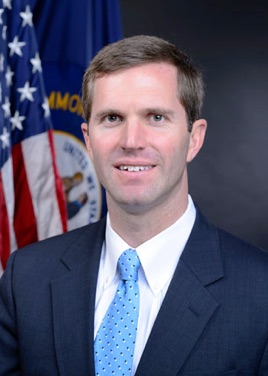

IN THE SUPREME COURT OF THE UNITED STATES
STATE OF WEST VIRGINIA, ET AL., APPLICANTS
v.
ENVIRONMENTAL PROTECTION AGENCY, ET AL.
(excerpt from EPA Memorandum opposing stay of rule)
The second rule is the Clean Power Plan, and it establishes Section 7411(d) emission guidelines for States to follow in developing plans to limit CO2 emissions from existing power plants.
The Rule also set forth EPA’s determination that the “best system of emission reduction” “adequately demonstrated” for existing plants includes a combination of three measures, referred to as “building blocks”:
1.(1)improving heat rate at coal-fired steam plants;
(2) substituting increased generation from lower-emitting existing natural gas combined cycle plants for generation from higher-emitting steam plants (which are primarily coal-fired); and
(3) substituting increased generation from new zero emitting renewable energy generating capacity for generation from fossil-fuel-fired plants (which are primarily coal- or gas-fired).
See 80 Fed. Reg. at 64,666-64,667.
EPA determined that these measures were “adequately demonstrated” because each of them is already a “well-established” technique for reducing CO2 emissions from power plants. Id. at 64,709. EPA further determined that these measures taken together constitute the “best system of emission reduction” because they can achieve substantial CO2 reductions at reasonable cost, without adverse impacts on energy availability or otherwise. Id. at 64,744-64,751. EPA also determined that individual sources can implement all of these measures, including the second and third generation-shifting measures, through a set of actions that range from making direct investments in zero- or low-emitting plants to purchasing emission-rate credits from entities that have made such investments. Id. at 64,709.
Having identified the “best” CO2 reduction system, EPA then quantified the degree of emission reduction achievable under that system for two subcategories of sources: steam units (which are primarily coal-fired) and combustion turbines (which are primarily gas-fired). 80 Fed. Reg. at 64,663. To best reflect the Nation’s interconnected electrical system, EPA quantified the reductions achievable in 2030 for each subcategory in each of three regions. Ibid.; see id. at 64,738. EPA then established uniform performance levels for each subcategory based on the least stringent of the three calculated regional rates. Id. at 64,741-64,742, 64,961 (Tbl. 1).
On Tuesday February 9, 2016 the Roberts Supreme Court stayed the rule pending disposition of writ of certiorari.
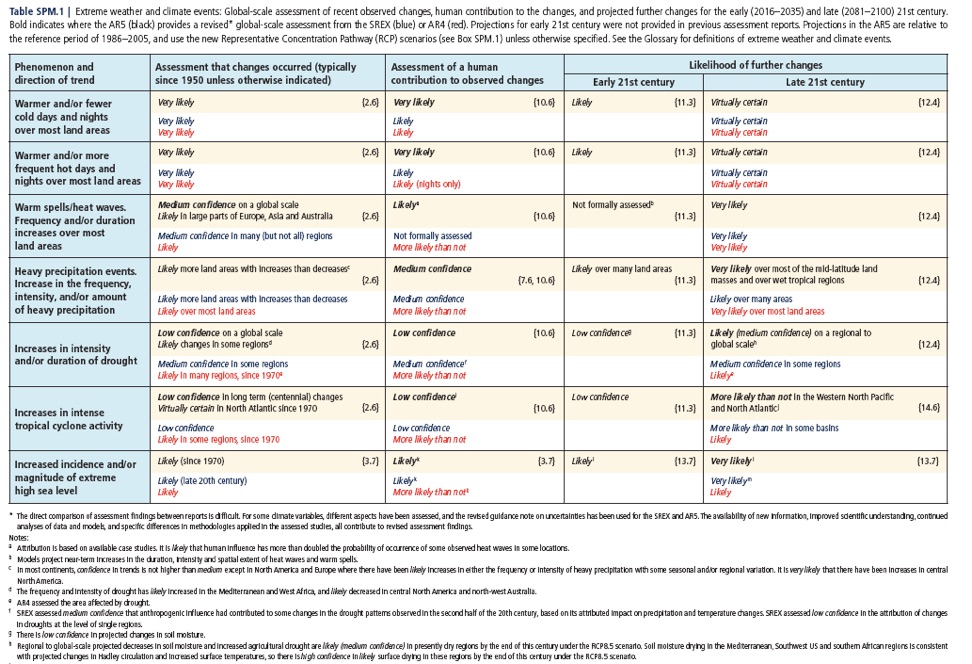

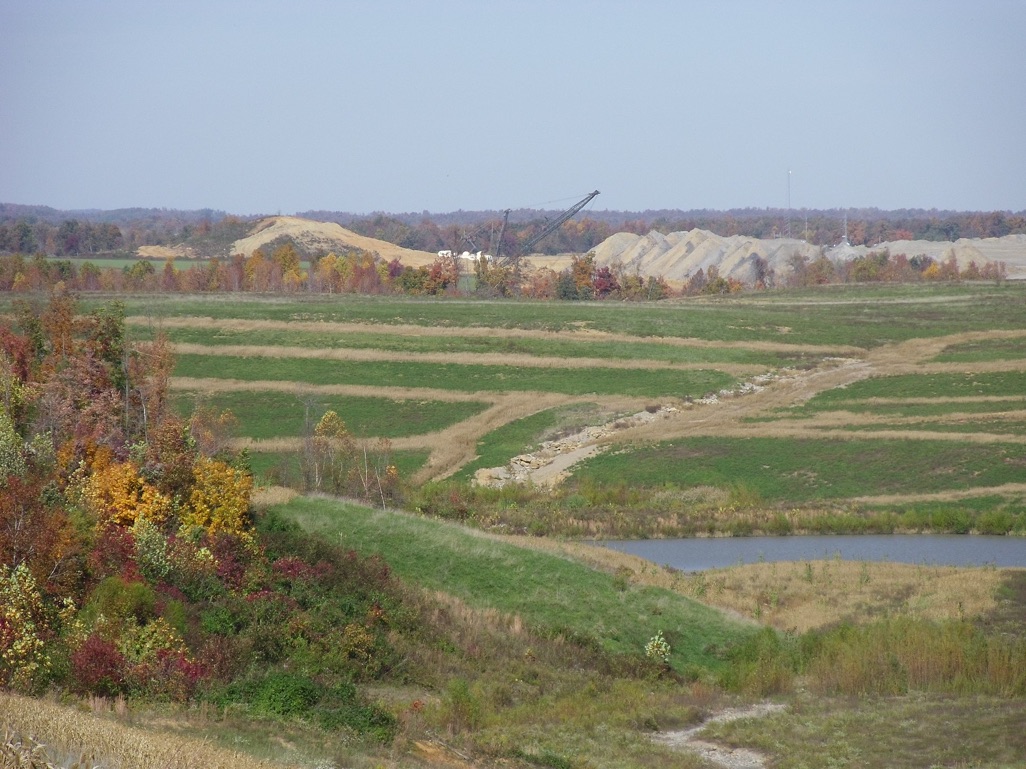

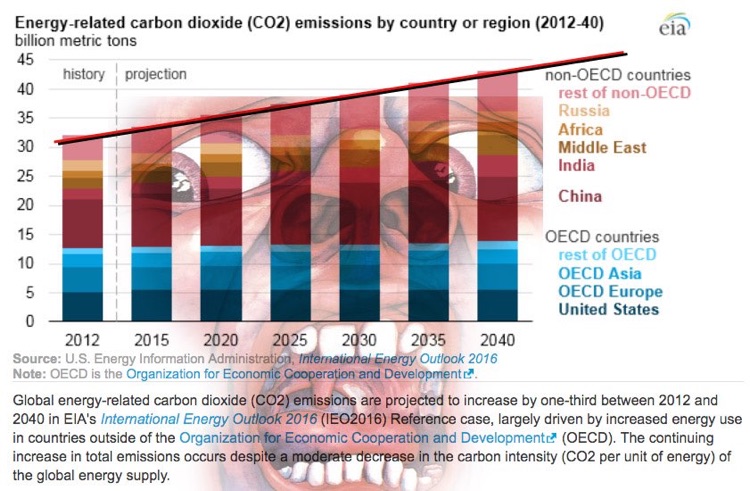
Graph source NASA: http://earthobservatory.nasa.gov/Features/GlobalWarming/images/ipcc_scenarios.png
World Temperature Could Rise 1.5°C by 2020
Global warming could occur more quickly than expected, according to modeling published in PLoS One (www.tinyurl.com/jm6bbx8).
The model, developed by Prof Ben Hankamer of The University of Queensland’s Institute for Molecular Bioscience and Dr Liam Wagner of Griffith University, forecasts that population and economic growth combined with rising energy use per person could significantly increase global energy demand and CO2 emissions, causing world average temperatures to rise by 1.5°C as early as 2020.
OFF BY 20 YEARS
ACTUAL v. MODELED Emissions
and corresponding global ambient surface
temperature rise show HIGH SIDE BREAKOUT
Models are not capturing all the greenhouse gas emissions including methane release and temperature rise is coming higher -sooner than computer modeled.
“The year-to-date temperature across global land and ocean surfaces was 1.75°F above the 20th century average of 57.4°F. This was the highest for January–October in the 1880–2016 record, surpassing the previous record set in 2015 by 0.18°F.
The year-to-date globally averaged land surface temperature was 2.66°F above the 20th century average. This was the highest for January–October in the 1880–2016 record, exceeding the previous record of 2015 by 0.34°F.”
NOAA.GOV State of the Climate Report

World Bank “Turn Down the Heat”
“The consequences for development would be severe as crop yields decline, water resources change, diseases move into new ranges, and sea levels rise. Ending poverty, increasing global prosperity and reducing global inequality, already difficult, will be much harder with 2°C warming, but at 4°C there is serious doubt whether these goals can be achieved at all.”
“Many of the worst projected climate impacts outlined in this latest report could still be avoided by holding warming below 2°C. But, this will require substantial technological, economic, institutional and
behavioral change. It will require leadership at every level of society.”
“Today the scientific evidence is overwhelming, and it’s clear that we cannot continue down the current path of unchecked, growing emissions.”
“Unfortunately, that is not likely to happen, and the reasons are straightforward: The economic, political, and geological forces aligned against coal — chief among them the increasing abundance of cheaper, cleaner, U.S.-produced natural gas — dwarf the impact that the federal government’s regulations have had on the coal industry.
These larger forces are far greater than Trump will be able to overcome through his promises to “end the war on coal” by “conduct[ing] a top-down review of all anti-coal regulations issued by the Obama Administration,” as stated in his transition team’s plan for “energy independence.”
The truth is that voters in coal country have been sold a bill of goods by this would-be savior of the coal industry. Indeed, Trump’s promised crusade against federal regulations in the energy sector is likely to benefit natural gas producers more than the coal industry, further widening the gap between the two fossil fuel sectors.
The truth is that voters in West Virginia, Kentucky, Wyoming and other coal-producing states — areas where Trump crushed Clinton with 63 percent to 70 percent of the vote — have been sold a bill of goods by this would-be savior of the coal industry and its mining jobs.”
01 Dec 2016: Opinion
Why U.S. Coal Industry and
Its Jobs Are Not Coming Back
President-elect Donald J. Trump has vowed to revive U.S. coal production and bring back thousands of jobs. But it’s basic economics and international concern about climate change that have crushed the American coal industry, not environmental regulations.
by james van nostrand
https://e360.yale.edu/feature/why_us_coal_industry_and_its_jobs_are_not_coming_back/3059/
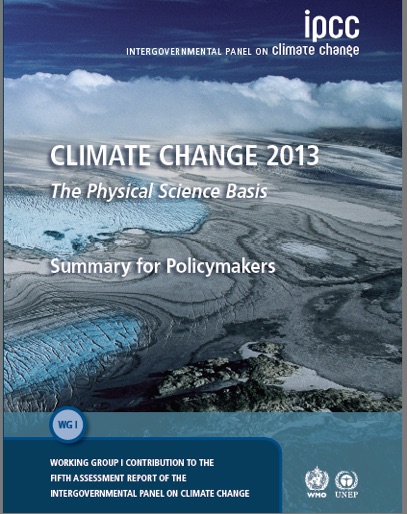
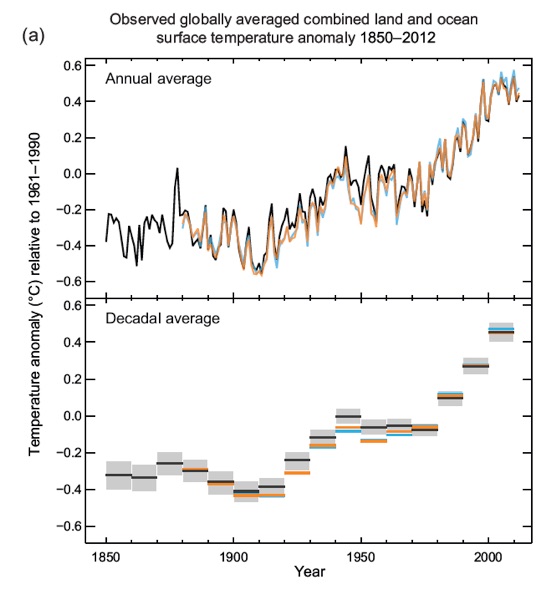
Published online at Louisville, Kentucky USA -
An independent, secular, contemporary journal of political and environmental issues dedicated to peaceful reduction of human impacts on Earth




Victor Garber as Thomas Andrews, designer of the Titanic 1997 James Cameron film. “I assure you sir, it is a "mathematical certainty" that the ship will sink.” Bernard Hill as Capt. Edward John Smith.
Above: Scott G. Anderson as Frederick Fleet,
“Iceberg–dead ahead!”
Ewan Stewart as First Officer William Murdoch on the bridge when the Titanic hit the iceberg.
Opposite: 1958 British film, “A Night to Remember” April 14-15, 1912. 1,500 deaths.